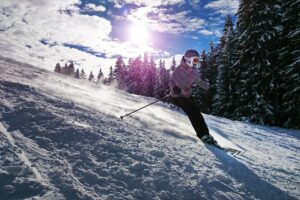Ski bindings are an essential piece of ski gear that can make or break your skiing experience. The binding is the interface between the ski and the boot and plays a crucial role in transmitting power and controlling the ski. In this article, we will look at the best ski bindings for all-mountain and backcountry skiing.
Alpine
The Marker Griffon 13 ID is one of the best alpine ski bindings. It has an all-metal construction for durability, elasticity for shock absorption, and a wide mounting platform for power transmission.
Touring Binding
If you’re looking for a touring binding, the Tyrolia Attack 13 GW is a great option. It has a lightweight construction, adjustable toe height for easy stepping into the binding, and a lateral release to help prevent knee injuries in deep snow.
GripWalk
Salomon S/Lab Shift MNC is a new ski binding model that supports both touring ski boot soles and alpine ski boot soles. It also features a multi-norm certification for compatibility with GripWalk soles.
Downhill Performance
For aggressive skiers who want the best downhill performance, the Strive 14 GW is a great option. It has a DIN range from 5 to 14 and features a wide heel piece for power transmission and elasticity for shock absorption.
Binding on the Market
The Look Pivot 18 is considered to be the best downhill ski binding on the market for expert skiers. It is designed to provide the best power transmission and elasticity in a downhill ski binding, and features a turntable heel piece for optimal edge control.
Basic Text
The most important factor when choosing a ski binding is the release value, which is the amount of force required to release from the binding. This varies depending on the skier’s weight, height, age, and skill level. The DIN range on a ski binding indicates the range of release values the binding can accommodate. Bindings are also set up differently for all-mountain skiing versus backcountry skiing. For all-mountain skiing, you want a binding that is closer to the ski for better power transfer, whereas for backcountry skiing, you want a lighter weight binding with a higher stack height to accommodate touring boots.
Lists
Here are some of the best ski bindings for different types of skiers:
- All-Mountain Skiers: Marker Griffon 13 ID
- Backcountry Skiers: Tyrolia Attack 13 GW
- Freeriders: Strive 14 GW
- Expert Skiers: Look Pivot 18
And here are some factors to consider when choosing a ski binding:
- DIN Range: Make sure the binding accommodates your release value.
- Stack Height: For touring bindings, look for a higher stack height to accommodate touring boots.
- Weight: Consider the weight of the binding if you’ll be doing a lot of uphill skiing.
- Power Transmission: Look for wider heel pieces for better power transfer.
- Elastic Travel: This can help prevent knee injuries in deep snow.
Tables
Here’s a comparison table of some popular ski bindings:
| Binding | DIN Range | Weight | Brake Width | Price |
|---|---|---|---|---|
| Marker Griffon 13 ID | 4-13 | 240g | 90/100/110mm | $315 |
| Tyrolia Attack 13 GW | 4-13 | 210g | 90/100/110mm | $370 |
| Strive 14 GW | 5-14 | 227g | 90/100/110mm | $480 |
| Look Pivot 18 | 8-18 | 1250g | 95/115/130mm | $449.95 |
Conclusion
Choosing the right ski binding is critical for the perfect ski experience. Look for the release value, weight, stack height, power transmission, and elastic travel to make the right decision. The above-listed brands are among the best ski bindings for all-mountain and backcountry skiing.
